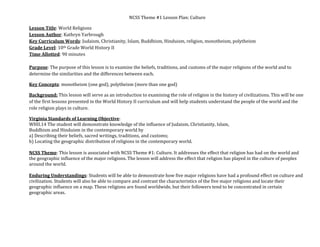
World religions
- 2. Facts/Concepts: Christianity • Monotheism • Jesus as Son of God • Life after death • New Testament—Life and teachings of Jesus • Establishment of Christian doctrine by early church councils Islam • Monotheism • Muhammad the prophet • Koran • Five Pillars of Islam • Mecca and Medina Buddhism • Founder—Siddhartha Gautama (Buddha) • Four Noble Truths • Eightfold Path to Enlightenment • Spread of Buddhism from India to China and other parts of Asia, resulting from Asoka’s missionaries and their writings Hinduism • Many forms of one deity • Caste system • Reincarnation • Karma—Future reincarnation based on present behavior Judaism • Monotheism • Ten Commandments of moral and religious conduct • Torah—Written record and beliefs of Hebrews Geographical distribution of world’s major religions • Hinduism—Concentrated in India • Judaism—Concentrated in Israel and North America • Buddhism—Concentrated in East and Southeast Asia • Christianity —Concentrated in Europe, North and South America • Islam—Concentrated in the Middle East, Africa, and Asia
- 3. Skills: • Identify, analyze, and interpret primary and secondary sources to make generalizations about events and life in world history. (WHII.1a) • Use maps, globes, artifacts, and pictures to analyze the physical and cultural landscapes of the world and to interpret the past. (WHII.1b) • Identify and compare contemporary political boundaries with the location of civilizations, empires, and kingdoms. (WHII.1d) • Analyze trends in human migration and cultural interaction. (WHII.1e) Values/Attitudes: • Religion plays a role in the development of culture • Religion has affected world civilizations Guiding Questions: • What are some characteristics of the five major world religions? • What are the major similarities and the major differences between the five major world religions? • How does religion affect the world today? • What major conflicts have been influenced or caused by religion? • How has religion played a role in your culture or life? • Where are the followers of the five major religions concentrated? Lesson Objectives: 1. Students will research and learn the basic concepts, facts, and traditions of the five major religions of the world. 2. Students will be asked to evaluate the effect that religions have had on history, the major similarities and differences between religions, and will determine the geographic distribution of the major religions by identifying them on a map. 3. Students will discuss in presentations that 5 distinct religions evolved from the ideas of monotheism and polytheism by 610 CE (Common Era), with Judaism, Christianity and Islam deriving from monotheism and Hinduism and Buddhism evolving from polytheism. 4. Students will observe that each religion is dominant in a distinct region of the world and influences that region’s customs, politics and social order even up to modern times. Materials: • Three or four sources for students to use for each major religion(books from the library, articles, internet sites, textbooks, etc) • World Religions Charts for students to complete
- 7. MAJOR BELIEF SYSTEMS IN OUR WORLD Religion or Belief Place of Major Beliefs and Ideas System Worship Christianity Judaism Islam Hinduism Buddhism
- 8. Geography Review: Fill in the following items on the map. The map will be turned for a grade 1)Shade the areas that are predominantly Christian red 2)Shade the areas that are predominantly Jewish purple 3)Shade the areas that are predominantly Muslim green 4)Shade the areas that are predominantly Hindu yellow 5)Shade the areas that are predominantly Buddhist orange 6)Label Africa, Asia, Europe, Australia, North America, South America and Antarctica 7)Draw in and label the lines of latitude and the lines of longitude 8)Draw and label the Prime Meridian and the Equator 9)Color the Oceans blue 10) Label the Pacific, Atlantic, Indian and Arctic Oceans 11) Label the Mediterranean Sea and color it blue 12) Label the compass rose on the map with these directions: north, south, east, west, northeast, southeast, northwest, southwest
